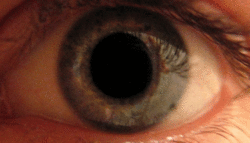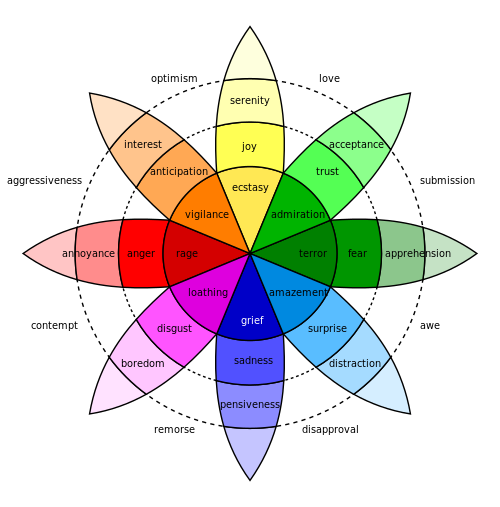Oculesics
[1][2] Communication scholars use the term "oculesics" to refer to the investigation of culturally-fluctuating propensities and appreciations of visual attention, gaze and other implicitly effusive elements of the eyes.[3] Comparatively, medical professionals may ascribe the same appellation to the measurement of a patient's ocular faculty, especially subsequent a cerebral or other injury (e.g., a concussion).As an anthropologist, he coined the term kinesics, and defined it as communication and perceived meaning from facial expressions and body gestures.He published his results in attempt to make general translations of gestures and expressions, although he later acknowledged it was impossible to equate each form of body language with a specific meaning.[13] He also served as an advisor for the television show Lie to Me, and worked with the Dalai Lama on increasing awareness of the influence of emotion on behavior to help people achieve peace of mind.[14][15] Ekman's work in facial expressions includes studies looking for connections between oculesics and other facial movements,[16] eye behavior and physically covering the eyes when recalling personal traumatic events,[17] and on his self-coined phrase, "the Duchenne smile" (named after Guillaume Duchenne), which relates to involuntary movements of the orbicularis oculi, pars orbitalis when smiling sincerely.[18] Most prominently, oculesics play a major role in the Facial Action Coding System, which is a micro-expression database created by Dr. Ekman and his colleagues.[23] Dr. Francine Shapiro developed eye movement desensitization and reprocessing (EMDR) treatment to address diseases such as posttraumatic stress disorder.[24][25] EMDR communicates with the subject through eye movement in an attempt to re-create meaning and processing of prior traumatic events.[26] Theory [27] proposed by psychologist and psychotherapist Carlos Prada which suggests the existence of specific pathways in the visual system through which dominance is transmitted and processed.[29] The pseudoscientific study of neuro-linguistic programming (NLP) established three main types of thinking regarding what someone sees, hears, or feels.Dr. Ekman states there are 15 basic emotions – amusement, anger, contempt, contentment, disgust, embarrassment, excitement, fear, guilt, pride in achievement, relief, sadness/distress, satisfaction, sensory pleasure, and shame – with each of these fifteen stemming out to similar and related sub-emotions.Some theorists say that even with these differences, there can be generally accepted "truths" about oculesics, such as the theory that constant eye contact between two people is physically and mentally uncomfortable."[38] Culture in this sense, includes all of the nonverbal communication, customs, thought, speech and artifacts that make a group of people unique.[40] The result of projected similarity is that misperceptions, misinterpretations, and misunderstandings occur in cross-cultural interactions when a person interprets another's nonverbal communication in the light of his or her own cultural norms.[38] In some countries, doctors use the study of oculesics to test stimulation among patients and interest levels in children who are not as expressive verbally.[40] In the Latino culture, direct or prolonged eye contact can also indicate that you are challenging the individual with whom you are speaking, or that you have a romantic interest in the person.





eye contactkinesicsnonverbalcommunicationmedicinesocial scienceconcussionnonverbal communicationChronemicsHapticsOlfacticsParalanguageProxemicsEye movementsaccadessmooth pursuitvergencevestibulo-ocularoptokineticPupillary responseGazingRay Birdwhistellanthropologistfacial expressionsgesturesPaul EkmanpsychologistLie to MeDalai LamaDuchenne smileGuillaume Duchenneorbicularis oculi, pars orbitalisFacial Action Coding SystemRobert PlutchikFrancine Shapiroeye movement desensitization and reprocessingposttraumatic stress disorderpsychotherapistvisual systemdominancedominant eyevisual cortexcognitive modulelateralization of brain functionoptic nerveoptic chiasmambidextrousinterpersonal relationshipsocular dominanceCarroll Ellis IzardemotionContrasting and categorization of emotionsPlutchik's Wheel of EmotionsAnxietyBoredomDesireDisgustHappinessInterestSadnessSurpriseSquintingBlinkingWinkingPupil dilationUnited StatesJacques LacanOrthopticsVisual perceptionVision therapyModalitiesBlushingBody languageBody-to-body communicationFacial expressionMicroexpressionSubtle expressionGestureSpeech-independent gesturesHaptic communicationImitationLaughterOlfactionPostureSpeechAffectEmotional prosodyIntonationLoudnessProsodyRhythmStressVoice qualitySocial contextConventionsDisplay rulesHabitusHigh-context and low-context culturesInterpersonal relationshipSocial normEmoticonSmileyOne-bit messageMissed callSilent service codeUnconsciousNon-verbal leakageAffect displayDeceptionEmotion recognitionFirst impressionIntimacyBasic interpersonal communicative skillsEmotional intelligenceNunchiPeople skillsSemioticsSocial behaviorSocial cueSocial competenceSocial skillsUnsaidAprosodiaAsperger syndromeAutismFragile X